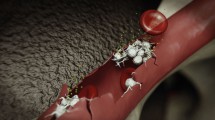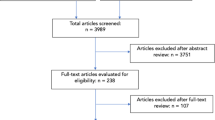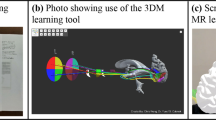Abstract
The animal research community faces a shortage of surgical training opportunities along with an increasing demand for expertise in surgical techniques. One possible means of overcoming this challenge is the use of computer-based or electronic learning (e-learning) to disseminate material to a broad range of animal users. E-learning platforms can take many different forms, ranging from simple text documents that are posted online to complex virtual courses that incorporate dynamic video or audio content and in which students and instructors can interact in real time. The authors present an overview of e-learning and discuss its potential benefits as a supplement to hands-on rodent surgical training. They also discuss a few basic considerations in developing and implementing electronic courses.
This is a preview of subscription content, access via your institution
Access options
Subscribe to this journal
We are sorry, but there is no personal subscription option available for your country.
Buy this article
- Purchase on Springer Link
- Instant access to full article PDF
Prices may be subject to local taxes which are calculated during checkout
Similar content being viewed by others
References
National Research Council, Committee on Rodents, Institute of Laboratory Animal Resources, Commission on Life Sciences. Rodents (National Academies, Washington, DC, 1996).
Baran, S.W. Rodent Laparoscopy. Laboratory Animal Science and Technology Seminar. Phoenixville, PA. 28 March 2009.
Becker, C., Fantini, M.C. & Neurath, M.F. High resolution colonoscopy in live mice. Nat. Protoc. 1, 2900–2904 (2006).
Baran, S.W., Johnson, E.J., Kehler, J. & Hankenson, F.C. Development and Implementation of Multimedia Content for Web-based Rodent Microsurgery Courses. 59th American Association of Laboratory Animal Science National Meeting. Indianapolis, IN. 11 November 2008.
Buzzell, P.R., Chamberlain, V.M. & Pintauro, S.J. The effectiveness of web-based, multimedia tutorials for teaching methods of human body composition analysis. Adv. Physiol. Educ. 26, 21–29 (2002).
Shomaker, T.S., Ricks, D.J. & Hale, D.C. A prospective, randomized controlled study of computer-assisted learning in parasitology. Acad. Med. 77, 446–449 (2002).
Komolpis, R. & Johnson, R.A. Web-based orthodontic instruction and assessment. J. Dent. Educ. 66, 650–658 (2002).
Sigulem, D.M. et al. A Web-based distance education course in nutrition in public health: case study. J. Med. Internet Res. 3, E16 (2001).
Ward, J.P., Gordon, J., Field, M.J. & Lehmann, H.P. Communication and information technology in medical education. Lancet 357, 792–796 (2001).
Bernardo, V. et al. Web-based learning in undergraduate medical education: development and assessment of an online course on experimental surgery. Int. J. Med. Inform. 73, 731–42 (2004).
Michigan Department of Educational Technology and Data Coordination. Leading Educational Transformation for Today's Global Society: State of Michigan Educational Technology Plan [online] <http://www.michigan.gov/documents/STP2006_5-10-06c_158945_7.pdf> (2006).
Lewis, L., Farris, E., Snow, K. & Levin, D. Distance Education at Postsecondary Education Institutions: 1997–98 (National Center for Education Statistics, Washington, DC, 1999).
Waits, T. & Lewis, L. Distance Education at Degree-Granting Postsecondary Institutions: 2000–2001 (National Center for Education Statistics, Washington, DC, 2003).
Boehle, S., Dobbs, K. & Stamps, D. Two views of distance learning. Training 37, 34–36 (2000).
Armstrong, L. Distance learning. Change 32, 20–28 (2000).
The Sloan Consortium. Growing by Degrees: Online Education in the United States (The Sloan Consortium, Boston, 2005).
Twigg, C. Improving learning and reducing costs: New models for online learning. EDUCAUSE Review 38, 28–38 (2003).
Bishop, T.M. The return on investment in online education. J. Vet. Med. Educ. 34, 258–262 (2007).
Acor, G.K. “Blended” online technology: maximizing instructor reach. J. Vet. Med. Educ. 32, 51–56 (2005).
Sherry, L. Issues in distance learning. International Journal of Educational Telecommunications 1, 337–365 (1996).
Childs, S., Blenkinsopp, E., Hall, A. & Walton, G. Effective e-learning for health professionals and students—barriers and their solutions. A systematic review of the literature—findings from the HeXL project. Health Info. Libr. J. 22, 220–232 (2005).
Levett-Jones, T.L. Self-directed learning: implications and limitations for undergraduate nursing education. Nurse Educ. Today 25, 363–368 (2005).
Dorrian, J. & Wache, D. Introduction of an online approach to flexible learning for on-campus and distance education students: lessons learned and ways forward. Nurse Educ. Today 29, 157–167 (2009).
Pritchard, W.R. Future Directions for Veterinary Medicine (Pew National Veterinary Education Program, Duke University, Durham, NC, 1989).
Brown, J.P. & Silverman, J.D. The current and future market for veterinarians and veterinary medical services in the United States. J. Am. Vet. Med. Assoc. 215, 161–183 (1999).
Adams, S.B. et al. Retention of surgery specialists in academia: a critical agenda. J. Vet. Med. Educ. 32, 404–415 (2005).
Freeman, L.C. R(X) for recruitment and retention of veterinarian scientists: money, marketing, mentoring. J. Vet. Med. Educ. 32, 328–336 (2005).
Grauer, G.F. Recruiting faculty with clinical responsibilities: factors that influence a decision to accept an academic position. J. Vet. Med. Educ. 32, 366–372 (2005).
Baran, S.W., Kehler, J. & Johnson, E.J. Laboratory Animal Science E-learning: An Answer for the Future. The 3rd Asian Federation of Laboratory Animal Science Associations Congress and the 8th Chinese Association of Laboratory Animal Sciences Annual Meeting. Beijing, China. 28 September 2008.
Matute, A. & Talcott, M. Overview in Techniques in Suturing and New Techniques for Skin Closures. Academy of Surgical Research 22nd Annual Meeting. Scottsdale, AZ. 23 September 2006.
Hoyt, R.F. Introduction to Microsurgery. 59th American Association of Laboratory Animal Science National Meeting. Indianapolis, IN. 11 November 2008.
Hoyt, R.F. Advanced Microsurgery Training. 59th American Association of Laboratory Animal Science National Meeting. Indianapolis, IN. 11 November 2008.
Bernal, J. Are Your Knots Holding? Suturing Skills Training Workshop. 59th American Association of Laboratory Animal Science National Meeting. Indianapolis, IN. 10 November 2008.
Murphy-Hackley, P. Implantation Techniques for Osmotic Minipumps. 59th American Association of Laboratory Animal Science National Meeting. Indianapolis, IN. 11 November 2008.
Fitzpatrick, M. Learning surgery online in Ireland. JAMA 284, 821 (2000).
Gomez, E.G., Ehrenberger, H., Murray, P.J. & King, C.R. The impact of the national information infrastructure of distance education and the changing role of the nurse. Oncol. Nurs. Forum 10, 16–20 (1998).
Messina, B.A. Distance learning: an option for your future? J. Perianesth. Nurs. 17, 304–309 (2002).
Mulligan, R. & Geary, S. Requiring writing, ensuring distance learning outcomes. International Journal of Instructional Media 26, 387–396 (1999).
Peterman, T.W. Elements of success at a traditional/virtual university: Lessons learned from three years of growth in cyberspace. Journal of Academic Librarianship 26, 27–32 (2000).
Bacsich, P. et al. The Costs of Networked Learning (Sheffield Hallam University, Sheffield, UK, 1999).
Bacsich, P., Ash, C. & Heginbotham, S. The Costs of Networked Learning—Phase 2 (Activity Based Costing) (Sheffield Hallam University, Sheffield, UK, 2001).
Johnstone, S. & Poulin, R. So how much do educational technologies really cost? Change 34, 21–23 (2002).
Bacsich, P. Somewhere between money pit and cash cow. NUTN Radio [online] <http://nutn.org/radio/archives.html> (2006).
Howson, J. & Mitchell, M. Course costing in devolved institutions: perspectives from an academic department. Higher Education Review 25, 7–35 (1995).
Bishop, T. & SchWeber, C. in Online Education (eds. Bourne, J. & Moore, J.C.) 173–182 (Sloan Center for Online Education, Needham, MA, 2001).
Gold, J.P. et al. Successful implementation of a novel hybrid surgery curriculum: the early phase outcome of thoracic surgery prerequisite curriculum e-learning project. Ann. Surg. 240, 499–507 (2004).
Sieber, J.E. Misconceptions and realities about teaching online. Sci. Eng. Ethics 11, 329–340 (2005).
Baran, S.W., Johnson, E.J. & Kehler, J. A guide for developing effective online surgical training courses. ALN Magazine [online] <http://www.alnmag.com/articles.asp?pid=417> (2009).
Dwyer, F. & Li, N. Distance education complexities: questions to be answered. International Journal of Instructional Media 27, 25–28 (2000).
Davis, M.J., Wythe, J., Rozum, J.S. & Gore, R.W. Use of World Wide Web server and browser software to support a first-year medical physiology course. Am. J. Physiol. 272, S1–S14 (1997).
Lovett, C. Cracks in the bedrock: can U.S. higher education remain number one? Change 34, 10–17 (2002).
Kendall, J.R. Support services for students and faculty. J. Vet. Med. Educ. 34, 251–256 (2007).
Western Cooperative for Educational Telecommunications. Beyond the Administrative Core: Creating Web-based Student Services for Online Learners [online] <http://www.wcet.info/services/studentservices/beyond/webcast/webcast.asp/> (2003).
Poulin, R. & Middleton, K. in Proceedings of World Conference on Educational Multimedia, Hypermedia and Telecommunications (eds. Barker, P. & Rebelsky, S.) 1323–1324 (2002).
Ponzurick, T.G., France, K.R. & Logar, C.M. Delivering graduate marketing education: An analysis of face to face versus distance education. Journal of Marketing Education 22, 180–191 (2000).
Barker, B. The Distance Education Handbook. An Administrator's Guide for Rural Remote Schools (ERIC Clearinghouse on Rural Education and Small Schools, Charleston, WV, 1992).
Beare, P. The comparative effectiveness of videotape, audiotape, and telelecture in delivering continuing teacher education. American Journal of Distance Education 3, 57–66 (1989).
McNeil, D.R. Computer Conferencing Project: Final Report (Academy for Educational Development, Washington, DC, 1991).
Carr, S. As distance education comes of age, the challenge is keeping students. Chronicle of Higher Education 46, 39–42 (2000).
Petracchi, H.E. & Patchner, M.E. A comparison of live instructional and interactive televised teaching: A 2-year assessment of teaching and MSW research methods course. Research on Social Work Practice 11, 108–117 (2001).
Bernardo, V. et al. Web-based learning in undergraduate medical education: development and assessment of an online course on experimental surgery. Int. J. Med. Inform. 73, 731–742 (2004).
Kaufman, H.H., Wiegand, R.L. & Tunick, R.H. Teaching surgeons to operate—principles of psychomotor skills training. Acta Neurochir. (Wien) 87, 1–7 (1987).
Rogers, D.A. et al. Peer teaching and computer-assisted learning: An effective combination for surgical skill training? J. Surg. Res. 92, 53–55 (2000).
Offerman, M.J. Institutional commitment: what it is and how to get it. J. Vet. Med. Educ. 34, 226–231 (2007).
Whitson, B.A., Hoang, C.D., Jie, T. & Maddaus, M.A. Technology-enhanced interactive surgical education. J. Surg. Res. 136, 13–18 (2006).
Goldenberg, D. & Beyar, R. The medical school Web site: medical education's newest tool. Isr. Med. Assoc. J. 2, 797–800 (2000).
Tello, R., Davidson, B.D. & Blickman, J.G. The virtual course: delivery of live and recorded continuing medical education material over the Internet. AJR Am. J. Roentgenol. 174, 1519–1521 (2000).
Bernardo, T.M. New technology imperatives in medical education. J. Vet. Med. Educ. 30, 318–325 (2003).
Delva, M.D., Kirby, J., Schultz, K. & Godwin, M. Assessing the relationship of learning approaches to workplace climate in clerkship and residency. Acad. Med. 79, 1120–1126 (2004).
Ozuah, P.O., Curtis, J. & Stein, R.E. Impact of problem-based learning on residents' self-directed learning. Arch. Pediatr. Adolesc. Med. 155, 669–672 (2001).
Acknowledgements
We thank Dr. F. Claire Hankenson for editing and review of this article.
Author information
Authors and Affiliations
Corresponding author
Ethics declarations
Competing interests
S.W.B. and E.J.J. are co-founders of the Veterinary Bioscience Institute, a for-profit company that provides online and mobile on-site rodent surgical training for the LAS community. J.K. is a member of the Veterinary Bioscience Institute's Advisory Board, a volunteer position.
Rights and permissions
About this article
Cite this article
Baran, S., Johnson, E. & Kehler, J. An introduction to electronic learning and its use to address challenges in surgical training. Lab Anim 38, 202–210 (2009). https://doi.org/10.1038/laban0609-202
Received:
Accepted:
Issue Date:
DOI: https://doi.org/10.1038/laban0609-202



